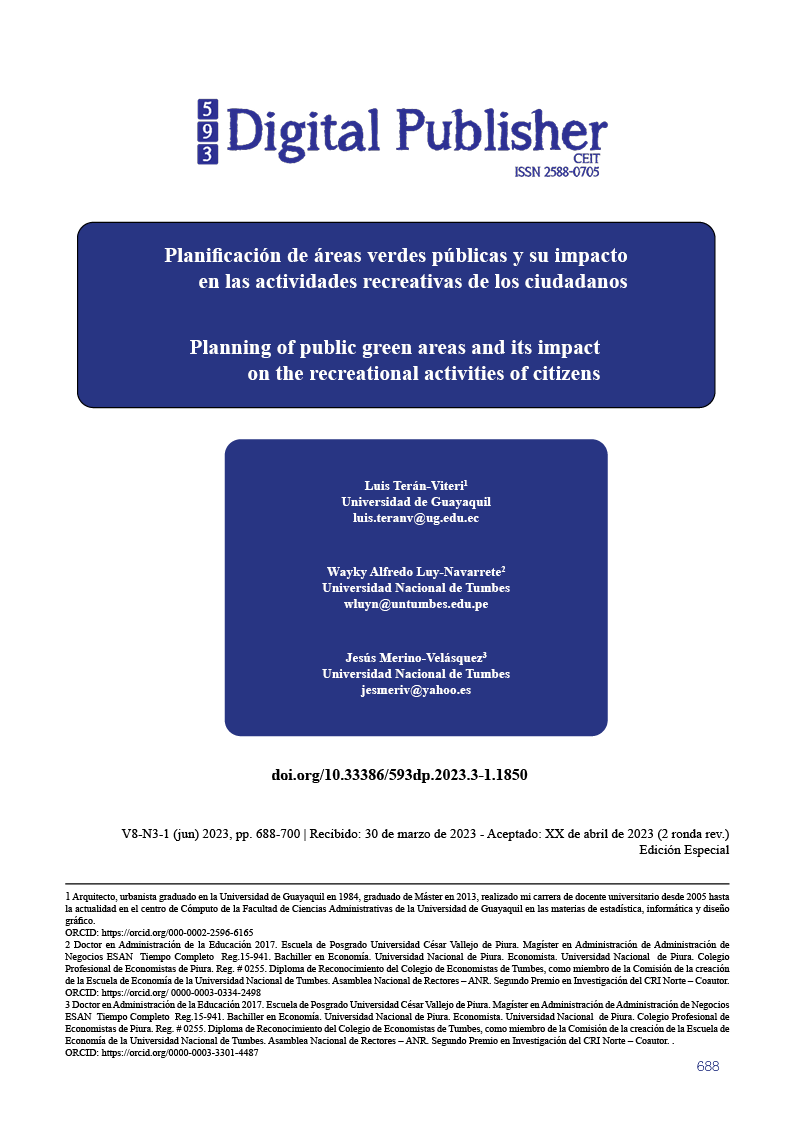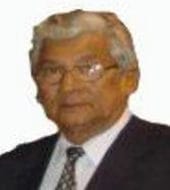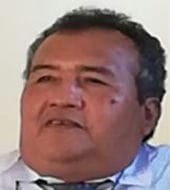Planning of public green areas and its impact on the recreational activities of citizens
Main Article Content
Abstract
It is important and necessary to provide technical information that serves to describe the current urban ecosystem of a sector of the city. Based on this, the objective of this research was based on analyzing what is the implication in the planning of public green areas in the recreational activities of citizens specifically in the Febres Cordero parish in Guayaquil. A cross-sectional descriptive and correlational and non-experimental methodology was applied; with a sample made up of 119 homes in which a survey of heads of household was used as an instrument, in terms of the results, Cronbach's alpha validation and reliability tests were carried out with a value of 0.87, proving to be suitable for its application. , subsequently the respective tests were carried out on the variables through the chi-square test method to determine the level of relationship between them, giving as a result that the significance value is less than 0.05, that is, 0.001, therefore, it was rejected. the null hypothesis and the alternative hypothesis was accepted, that is, that the planning of green areas is significantly related to recreational activities.
Downloads
Article Details

This work is licensed under a Creative Commons Attribution-NonCommercial-ShareAlike 4.0 International License.
1. Derechos de autor
Las obras que se publican en 593 Digital Publisher CEIT están sujetas a los siguientes términos:
1.1. 593 Digital Publisher CEIT, conserva los derechos patrimoniales (copyright) de las obras publicadas, favorece y permite la reutilización de las mismas bajo la licencia Licencia Creative Commons 4.0 de Reconocimiento-NoComercial-CompartirIgual 4.0, por lo cual se pueden copiar, usar, difundir, transmitir y exponer públicamente, siempre que:
1.1.a. Se cite la autoría y fuente original de su publicación (revista, editorial, URL).
1.1.b. No se usen para fines comerciales u onerosos.
1.1.c. Se mencione la existencia y especificaciones de esta licencia de uso.
References
Banco de Desarrollo de América Latina. (16 de marzo de 2020). Guayaquil contará con un plan de manejo de áreas verdes. Obtenido de https://www.caf.com/es/actualidad/noticias/2020/03/guayaquil-contara-con-un-plan-de-manejo-de-areas-verdes/
Bernal, P. (2018). La investigación en ciencias sociales. Técnicas de recolección de la información. Universidad Piloto de Colombia. Obtenido de http://dspacecicco.conacyt.gov.py/jspui/handle/123456789/67051
Bonilla, L. (octubre de 2015). Incidencia del índice verde urbano y su relación con la responsabilidad social empresarial: Sector Socio-Vivienda II. Guayaquil. Obtenido de http://repositorio.ug.edu.ec/handle/redug/11071
Burneo, A. (2019). Diseccion de la pobreza por ingreso en el sector del suburbio de la ciudad 2015-2018. Guayaquil: Universidad de Guayaquil. Obtenido de http://repositorio.ug.edu.ec/handle/redug/45540
Calaza, P. (2020). Guía de la infraestructura verde municipal. Obtenido de https://redbiodiversidad.es/sites/default/files/GUIA_Biodiversidad_CAPITULOS1_5.pdf
Canclini, N. G. (1995). Consumidores y ciudadanos. Conflictos multiculturales de la globalización. México: Grijalvo. Obtenido de https://blogs.bgsu.edu/span6350/files/2012/08/Canclini-Consumidores-y-Ciudadanos-fragmento.pdf
Carrasco, S. (2019). Metodología de la investigación científica. Lima: San Marcos.
Cruz-Rodriguez, M. (2019). Impacto ambiental y percepción social en el Parque.
De la fuente, A. (2020). Encuesta sobre el paisaje urbano en ciudades de Latinoamérica y el caribe. Obtenido de https://drive.google.com/file/d/1-axH8IuMMDYABLYjv-lqXkH8JqBI3_Oj/view?usp=sharing
Gupta, K., Kumar, P., Pathan, S., & SHarma, K. (2012). Urban Neighborhood Green Index – A measure of green spaces in urban areas. Landscape and Urban Planning, 105(3), 325-335. doi:https://doi.org/10.1016/j.landurbplan.2012.01.003
Hernández, R., Fernádez, C., & Batista, M. (2014). Metodología de la investigación (6ta edición ed.). México, D. F.: McGRAW-HILL / INTERAMERICANA EDITORES, S.A. DE C.V.
Instituto Nacional de Estadística y Censos, INEC. (2010). Población y demografía. Obtenido de https://www.ecuadorencifras.gob.ec/censo-de-poblacion-y-vivienda/
Instituto Nacional de Estadística y Censos, INEC. (2012). Índice Verde Urbano. Obtenido de https://www.ecuadorencifras.gob.ec/indice-verde-urbano/
López, M. (2018). La gestión sostenible del uso del espacio recreativo y su incidencia en el fortalecimiento de los procesos de integración social en el distrito de Cajamarca, 2017. Universidad César Vallejo. Obtenido de https://hdl.handle.net/20.500.12692/11776
Martinez, C., & Valdés, M. (2019). Dimension social de la crisis en Guayaquil y la educación ambiental a inicios de siglo. Revista Universidad y Sociedad, 11(4). Obtenido de http://scielo.sld.cu/scielo.php?pid=S2218-36202019000400258&script=sci_arttext&tl
Ministerio de Desarrollo Urbano y Vivienda. (Enero de 2015). Proyecto de Inversión. Obtenido de Generación de áreas verdes y espacios recreativos públicos para la provincia del Guayas-Guatas Ecológico: https://www.habitatyvivienda.gob.ec/wp-content/uploads/downloads/2015/06/PROYECTO-GUAYAS-ECOLOGICO-FINAL29-ENERO-V3-en-formulacion.pdf
Ministerio de Desarrollo Urbano y Vivienda, MIDUVI. (2015). Generación de áreas verdes y espacios recreativos públicos para la provincia del Guayas, Guayas Ecológico. Obtenido de https://docplayer.es/10649882-Generacion-de-areas-verdes-y-espacios-recreativos-publicos-para-la-provincia-del-guayas-guayas-ecologico.html
Moncada, B. (15 de 11 de 2020). El barrio que fue desalojado vuelve a las orillas del Estero Salado. Obtenido de https://www.expreso.ec/guayaquil/barrio-desalojado-vuelve-orillas-estero-salado-93587.html
Moncada, B., & López, V. (7 de enero de 2019). Diario Expreso. Obtenido de Pressreader: https://www.pressreader.com/ecuador/diario-expreso/20190107/281921659183933
Pérez, S. (2018). Legislación urbana y oferta de áreas verdes de recreación en Mérida, Yucatán. Estudios Demográficos Urbanos, 33(3). doi:https://doi.org/10.24201/edu.v33i3.1813
Primicias. (20 de Diciembre de 2020). Guayaquil aún lucha por aumentar sus espacios verdes. Recuperado el 2023, de http://www.primicias.ec/noticias/sociedad/guayaquil-aumentar-espacios-verdes/
Rodriguez, N. (2020). La influencia de las áreas recreativas públicas existentes en los patrones de convivencia del poblador del sector Manuel Arévalo III etapa, distrito de La Esperanza. Universidad César Vallejo. Obtenido de https://hdl.handle.net/20.500.12692/44791
Romo-Leroux, P. (2016). “Valoración Ambiental de las Áreas Verdes en la Parroquia Pedro Carbo del Cantón Guayaquil”. Guayaquil: Universidad de Guayaquil. Obtenido de http://repositorio.ug.edu.ec/handle/redug/26598
Vargas, L. (2019). Influencia de las áreas verdes en el bienestar de los ciudadanos en Bogotá, Colombia. Universidad del Rosario. doi:https://doi.org/10.48713/10336_18966
Vera, F., & Mashini, D. (15 de Mayo de 2020). Espacio público: 6 ideas para revitalizar los barrios el día despues de la COVID-19. Obtenido de https://blogs.iadb.org/ciudades-sostenibles/es/espacio-publico-6-ideas-para-revitalizar-barrios-el-dia-despues/
Yao, L., Liu, J., Wang, R., & Yin, K. (2014). Effective green equivalent—A measure of public green spaces for cities. Ecological Indicators, 47, 123-127. doi:10.1016/j.ecolind.2014.07.009




